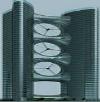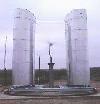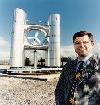Mankind has made big efforts to concentrate the wind for increasing the
natural windvelocity or to enlarge the power ratio. Windtunnel
investigations have delivered some hopefull result, but this was never
proofed in reality, up today.
Since 1996 we have a "new" old, huge, new-fangled saurian, a
device erected in New Zealand, look to the following adresses:
http://www.vortecenergy.co.nz/intro.htm
or to the picture-chips.
Some data: blade diameter 7,3 m; height 22 m; rated power 1,2 MW (at ?
m/s wind). The plant can double the ambient wind by suction effects,
has said the company.
But as usuall in such cases, the concept hasn't prooved its efficiency,
and nevertheless new machines are presented to the surprised
shareholders: The Maxi Vortec and the Mini Vortec, to be erected in the
first quarter of 1999?
Who will loose money is the question?
For example: Take the wonderfull inner rotor of the Maxi Vortec, as an
excellent slender free running turbine, and take all material (and
energy) of the huge shround and tubular strut and build, say 5 or 6 or
more further free running turbines from it. And than, please, compare
the output. . . . .
Actually, the Vortec Energy World Power Company is now going offshore,
to earn more money from new shareholders. The sketch shows a 5 MW
machine with a V66 blade
Ducted fans, shrouded turbines, diffusers, three names for the same
device but the same physical effect. You need a length for the well
shaped tube, 7 to 10 times the diameter of the rotor. The intake well
rounded, the diffuser flared to the end smoothly. The slot at the rotor
tip should reach a value of zero concerning the losses, and the wind,
absolutely homogenous, must go absolutely straight into the tube.
These conditions are not existing in a natural wind.
Think at a 70 m tube for a 10 m diameter windrotor. What happens if the
winddirection control fails? Terrible drag forces occur, perpendicular
to the tube-axis. And what's about the fluctuating winddirection in a
fraction of a second? If the control of the huge tube is not able to
follow absolutely exact a new winddirection, then a separation of flow
will occur at the inner wall of the intake. The result is a collapse of
the needed homogenous flow for a concentrating effect.
The question is: Is it possible to double the windvelocity for example
from 10 to 20 m/s? Experiments in windtunnels with excellent artificial
conditions, and with threefold rindflaps (Ozer Igra,1976) have shown a
concentrating effect of roughly 1.8.
To shorten the shroud you can try to work with slots or flaps to
control the inner boundary layer or to bring more energy from the outer
part of the windstream into the shroud.
The future of this experiment will become thrilling. The efforts in New
Zealand will give an answer to the wind fan company: Is there an
concentrating effect with this device in the atmospheric complete
turbulent boundary layer? The windenergy science has to live with a
complete turbulent boundary layer above all kinds of terrain, offered
by the natural wind to our earth, a layer 300 m thick, at least,
depending on the terrain structure. . . .and we can't reach the
jetstream unfortunately with devices being economically.
Perhaps the wind fan company will get the answer to a lot of further
very important questions:
Energy amount for this concentrating device, energy pay back factor,
maintenance costs, behaviour of the wind direction control mechanism,
lifetime a.s.o.
Personally I mean to this experiment in New Zealand: a better way to
use windenergy economically with hardware-machinery is:
take all the material for a vortex or concentrating device and build
up one HAWT (or even more), this means enlarge the rotor and try to
reach the biggest area cut out of the windstream and slowing down the
windvelocity to 1/3 by the rotor. This is the old Betz postulate
(1926). In this case, please have a sincere look to the least material
amount possible for the rotor and all subsystems.
If you want to double the windvelocity, if this is possible at all by a
diffuser vortex system, you can get the same effect with a 2.8 fold
diameter.
For example, precisely, build instead a 10 m HAWT better a 28 m plant,
the effect is the same, you get then the 8-fold power output naturally
for the same windvelocity and the same powercoefficient.
Look to the following references or click the above installed pictures:
Igra, O. "Shrouds for Aerogenerateurs", AIAA Journal, Vol.
14, No.10,
October 1976, p. 1481-1483
R.A. Oman, K.M. Foreman and B.L. Gilbert, "Investigation of Diffuser-Augmented Wind Turbines", PartII-Technical Report, ERDA, Report C00-2616-2, Jan. 1977.
Some more references:
Fletcher, H.S.
"Experimental Investigations of Lift, Drag and Pitching Moment of
Five Annular Airfoils"
NASA TN 4117, 1957
Glauert, H.
"The Elements of Airfoil and Airsrew Theory"
Cambridge University Press, Cambridge, 1959
Kogan, A. and Nissim, E.
"Shrouded Aerogenerator Design Study, Two-Dimensional Shroud
Performance"
Bulletin of the Research Council of Israel, Vol. 11c, 1962,
pp.67-88
Kogan, A. and Nissim, E.
"Shrouded Aerogenerator Design Study, Two-Dimensional Shroud
Performance"
Proceedings of the Fifth Israel Annual Conference on Aviation and
Astronautics, Israel, 1963
Kogan, A. and Seginer, A.
"Shrouded Aerogenerator Design Study II, Axisymmetrical Shroud
Performance"
Department of Aeronautical Engineering, Technion, T.A.E. Report 32, 1963,
also
Kogan, A. and Seginer, A.
"Final Report on Shroud Design"
Department of Aeronautical Engineering, Technion, T.A.E. Report 32A, 1963
Oman, R.A. and Foreman K.M.
"Cost Effective Diffuser Augmentation of Wind Turbine Power
Generators".
Grumman Aerospace Corporation, Bethpage, New York 11714,
Second Workshop on Wind Energy Conversion Systems, Washington, D.C.,
June 9-11, 1975
Igra, O.
"Design and Performance of a Turbine Suitable for an
Aerogenerator"
Energy Conversion, Vol. 15, 1976
Igra, O. and Schulgasser, K.
"Design and Construction of a Pilot Plant for a Shrouded Wind
Turbine"
Proceedings of the Second International Symposium on Wind Energy
Systems, F-1,
Amsterdam NL, Oct. 1978
O. Igra
Research and Development for Shrouded Wind Turbines
European Wind Energy Conference, Hamburg, 22.-26. October 1984,
Hamburg,
Proceedings, Pages 236-245
If you want some more informations about the most economiest wind utilizing system these days, then click
Nowadays in architecture some groups make earnest efforts to
concentrate the natural wind by buildings.
They propose to make the shape of new tal buildings in such a manner
that these structures act as huge parts of a diffuser.




One group you will find by using:
http://www.eru.rl.ac.uk/web.htm.
This is an ENERGY RESEARCH UNIT at the RUTHERFORD APPLETON LABORATORY
at Chilton, UK,
together with members of the University of Stuttgart, Germany, mail to:
joerg.hieber@po.uni-stuttgart.de
Meanwhile two new companies make some efforts in concentrating windssystems again,
the one in France:
http://www.cita-wind.com/index.htm,
the other in Germany:
http://www.kbe.de/frame.htm
click on: Branchen and then at Windkraftindustrie.
Time will show if these companies can beat the physics.
doerner@ifb.uni-stuttgart.de
![]() Since
20th of mai 1997
Since
20th of mai 1997